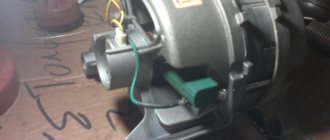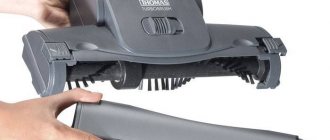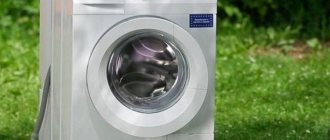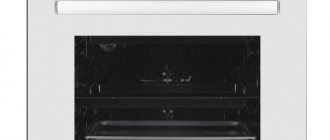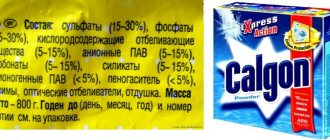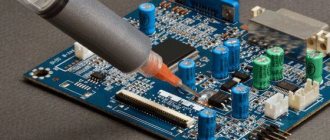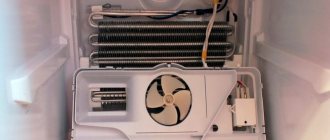There are different types of refrigerators based on the type of defrosting they do. The simplest models are the old generation refrigerators, for defrosting which it was necessary to use many trays and rags, otherwise all the melt water would flow out of the refrigerator. Modern models are more technologically advanced and allow you to optimize the defrosting process, which makes them easier to use. Read more about refrigerators with drip defrosting system in this article, as well as a comparison of this technology with “No Frost”.
Why do you need to defrost your refrigerator?
When food is cooled in the refrigerator, condensation forms - moisture on the internal surfaces of the unit, which then freezes into ice build-ups. Condensation can occur for several reasons, but in a working refrigerator, the first most common factor is hot food. If you put, for example, a pot of hot soup in the refrigerator, the escaping steam will settle inside the refrigerator as a liquid. This happens due to the temperature difference between the products and the unit itself.
Of course, it is not recommended to put foods that are too hot in the refrigerator, and you can refrain from doing so. But with the freezer, things are different; ice build-ups can form in it even simply from the fact that food at room temperature is placed inside, which needs to be cooled and frozen. Ice also appears from the difference in temperature between the environment and the freezer when we open the chamber door.
If you follow the rules of use: do not put anything hot inside the refrigerator, do not keep the door open for a long time, etc., then ice will appear in small quantities, but you still need to get rid of it.
Firstly , ice build-up interferes with the proper operation of the refrigerator. Because of them, it is more difficult for the unit’s engine to maintain the required temperature inside, so the engine wears out.
Secondly , it interferes with washing internal surfaces. Because of the ice, it will not be possible to thoroughly wash all the walls, and it itself may contain food residues or frozen dirt.
Thirdly , the useful space of the chambers, especially the freezer, is wasted. Ice takes up the space in which you could put something.
These factors were especially pronounced in older generation refrigerators. Condensation formed in them in large quantities and quickly froze, so the units had to be defrosted more often. This was more difficult to do than in modern models: it was necessary to unplug the refrigerator, place a tray into which water would drain, and use a lot of rags, because... There was a lot of water after this procedure.
For ease of use, modern refrigerators are not only made more resistant to temperature changes, but many models are also equipped with a drip defrosting system, which helps optimize the process of caring for the unit.
The best drip refrigerators
| Nomination | place | Name of product | price |
| The best drip refrigerators | 1 | Liebherr CNef 4815 | 56 860 ₽ |
| 2 | Bosch KGE39XW2AR | 33 790 ₽ | |
| 3 | Liebherr CUwb 3311 | 32 250 ₽ | |
| 4 | Gorenje NRC 6192 TX | — | |
| 5 | Bosch KGV39XW22R | 26 990 ₽ | |
| 6 | ATLANT XM 4625-101 | 22 775 ₽ | |
| 7 | BEKO RCSK 335M20 W | 18 990 ₽ |
Liebherr CNef 4815
Rating: 4.9
One of the most expensive refrigerators among those equipped with a drip defrosting system. This is a two-chamber monster, the body of which is silver in color. To open the door, a special pusher is used here, and minimal effort is required from a person. In short, even a small child can open the refrigerator door. This representative of our rating can also boast of fairly low energy consumption - experts have assigned it the corresponding class A+++.
To be honest, the device was included in our list undeservedly. The fact is that it cannot be said that the NoFrost system is not used here at all. It’s just used only in the freezer. This means that ice will definitely not appear in it. Well, the refrigerator compartment here actually has a drip defrosting system - at least the damp back wall speaks of this.
If your electricity suddenly goes out, the cold inside the device will remain for 24 hours - this is a very good result, almost ideal. The refrigerator also boasts high freezing capacity - up to 16 kg per day. It’s also nice that it’s impossible to forget to close the door of such a drip refrigerator - the electronics will immediately give a sound and even a light signal. By the way, LED backlighting is used here, which has virtually no effect on energy consumption.
What else explains the high cost of the Liebherr CNef 4815? Perhaps, the presence of a display right inside the device. Also, one cannot but rejoice at the noise level, which does not exceed 38 dB. Such a refrigerator could not fail to have a freshness zone - vegetables and fruits are stored here for a very long time. The fan also helps with this, trying to prevent the temperature from changing even when the door is opened.
In short, the refrigerator turned out great. The volume of its refrigerator compartment is 260 liters, and the freezer holds another 101 liters. It remains to be regretted that many Russians will not be able to afford such a monster - reaching 62 thousand rubles. the cost includes a loan. But if you can still afford such a purchase, then don’t think twice!
Advantages
- Belongs to energy class A+++;
- A handle with a pusher is used;
- Very low noise level;
- Large volume of both chambers;
- Decent freezing power;
- Long-term autonomous preservation of cold;
- Super cooling and super freezing available;
- There is a touch display;
- Light and sound indication of an open door and rising temperature;
- The freezer uses the NoFrost system;
- Durable glass shelves.
Flaws
- High price;
- Some people may find the refrigerator too tall.
What is drip technology?
Refrigerators equipped with such a system have a special recess on the back wall for moisture drainage. First, maximum cooling of the internal space occurs, and then the compressor turns off and the frozen condensate thaws. To ensure that frost accumulates only on the rear wall, there is a special evaporation element behind it.
Thus, the operation of a refrigerator with a drip defrosting system is based on the “freezing-thawing” principle. The compressor periodically turns off, and at this time the frozen condensate becomes liquid again and flows into a special recess. Then it goes into a container that can be reached from the back of the refrigerator.
Operating principle of the drip defrosting system
The essence of this technology is that steam does not condense on all internal surfaces of the refrigerator, but only on the back wall. It has the lowest temperature compared to other elements of the unit.
The temperature in the refrigerator itself is positive, and a special element is built into the back wall - an evaporator radiator, to which compressed refrigerant is supplied from the compressor. When a substance changes from liquid to gas, heat is absorbed. After this, the refrigerant has completed its function and is returned back to the compressor, where it is re-compressed and the cycle resumes.
When the thickness of the frost on the rear wall exceeds the permissible limit, a sensor will work and automatically turn off the compressor. Also analogous to the sensor is a timer that turns off the compressor at specified intervals. In the absence of cooling, the back wall quickly warms up to the temperature necessary for thawing the ice. The liquid flows down special recesses in the wall and enters a tube that leads into a plastic container.
This container is located in such a way that when the refrigerator engine is turned on, it begins to warm up evenly and the liquid evaporates. Some models require you to empty the water yourself.
Refrigerators with No Frost system
Advantages:
- Unlike the previous type, the “No Frost” system boasts the same temperature throughout the entire volume of the chamber, excluding specially designated freshness zones.
- Defrosting such a refrigerator is, although necessary, extremely rare. It is enough to carry out this procedure only once a year for prevention.
- Such a unit does not require any maintenance other than hygienic wiping of the shelves.
- No Frost is distinguished by a record speed of freezing food.
- It reaches the set temperature again just a few seconds after opening/closing the door.
- This system is most suitable for use in freezers.
Flaws:
- As a rule, such refrigerator models cost a little more.
- Due to its design features, the internal volume of the chamber is slightly smaller than that of its “crying” counterparts.
- The presence of fans in the cooling system means slightly noisier operation.
- Since there are more energy-consuming nodes in the system, it “eats” a little more electricity.
Attention! In No Frost refrigerators, you can sometimes notice a small amount of condensation on the back wall of the chamber. However, compared to the drip version, its quantity is minimal and indicates that you kept the refrigerator door open for a long time or placed foods with very high humidity in the chamber.
TOP 3 best No Frost refrigerators
- Samsung RB-30 J3200EF
- LG GA-B499 YAQZ
- BEKO RCNK 310K20 W
Reviews on Yandex.Market
Advantages and disadvantages of drip defrosting
Refrigerators with a drip defrosting system have a large number of advantages:
- no constant maintenance or care is required - the water container empties itself due to evaporation;
- the price is lower than other models, because no need to buy additional devices;
- low price for repairs and maintenance: firstly, such refrigerators have not been a new product for a long time, so there are quite a lot of repairmen in different price ranges, secondly, the drip system facilitates the operation of the refrigerator compressor, due to which breakdowns occur much less frequently;
- a variety of models with such a defrosting system - it is possible to make the perfect choice;
- the noise level is very low due to the special internal structure of the unit;
- increased useful volume of the chamber: ice build-ups do not interfere with putting in a larger quantity of products, and there is also no need to install various additional devices (pallets, etc.).
Like any equipment, such refrigerators have their disadvantages, which you need to know about before purchasing:
- the drip system does not automatically defrost the freezer - you will have to do this procedure yourself;
- There is an almost constant deposit of ice on the back wall: of course, it defrosts periodically, but it is impossible to completely get rid of it, because... ice helps maintain the required temperature in the chamber;
- the temperature in the refrigerator is not constant, its difference can be up to 6-8 degrees, this is due to the fact that the compressor must be turned off at certain intervals;
- you need to carefully ensure that the products do not touch the back wall, because... they may freeze or lose their quality due to exposure to melt water;
- if the channel through which the liquid flows into the container becomes clogged, then water will flood the refrigerator chamber and may even get inside it;
- metal parts of the refrigerant are constantly in contact with moisture, which is why rust may appear on them;
- after the first connection to the power grid, the refrigerator will need 8-10 hours to form a sufficient thickness of ice, without which the temperature in the chamber will be higher than necessary;
- If water gets on the insulator, an unpleasant odor appears.
what does it mean and reviews
Today, household appliance stores offer a large selection of refrigeration units. They are equipped with different systems that operate according to certain principles. One of the refrigerator defrosting systems is drip. Most of the units that we can see on store windows operate on this principle.
Short description
What is the drip option for defrosting refrigeration devices? This is a mechanism that includes a panel with an evaporator, which regulates the temperature inside the chambers without user intervention. During continuous operation of the drip system, ice does not accumulate on the walls of the device. All moisture, turning into condensation, accumulates on the surface of the inner panel and enters the evaporator container.
Drain hole in refrigerator
The drip mechanism for defrosting a refrigeration unit, or No frost, operates on the freeze-thaw principle. There is a special element on the rear panel that is necessary to accumulate ice while the compressor is operating. After the compressor unit is turned off, the ice thaws and flows into the container.
The drip principle of operation of the device occurs continuously, ensuring that the required temperature inside the chambers is maintained.
About the working principle
To understand what a drip defrosting system means, you need to consider an example of how the unit functions in practice.
- Any refrigerator with a drip system has a special panel that accumulates and removes excess condensation.
- The defrosting process occurs regularly without user intervention.
- All models of refrigeration devices with a drip defrosting system have a special alarm. If it is necessary to completely disconnect from the network and defrost, the unit signals this with sound signals.
Don’t worry about the last point; all models with the No Frost system work smoothly and with virtually no user intervention. However, this does not mean that the device does not require regular maintenance. Containers for accumulating condensate require periodic cleaning to prevent clogging.
Drip defrosting system
How to properly clean containers in LG No Frost refrigeration devices? It is recommended to study the instructions for the unit. Manufacturers describe in detail the entire process of maintaining refrigerators in their documentation.
About the positive and negative aspects of the system
Even the best refrigerators with a drip defrosting system have pros and cons in operation. To understand how convenient the LG No Frost system is, you need to study all the nuances and aspects of the device. What is good about this system?
- Models equipped with drip defrosting are always affordable.
- There is a wide range of models for buyers to choose from.
- Refrigerators with the drip principle are equipped with large chambers that can accommodate a large amount of food.
- These models consume little electricity.
- The devices operate almost silently.
No Frost LG
However, there are also negative aspects in the operation of the drip defrosting system.
- This system does not function in freezer compartments.
- The back of the chambers is always covered with ice.
- The upper and lower chambers differ in temperature by 2-5 degrees.
Best models
User reviews claim that the INDESIT ST 145 model is affordable and has excellent functional characteristics. The device is equipped with a drip defrosting principle, thanks to which the required temperature is maintained inside the refrigerator compartment and ice does not accumulate. The control of the device is simple, electromechanical. In terms of energy consumption, this unit belongs to class B.
INDESIT ST 145
Another popular option equipped with a drip defrosting system is the Pozis RK-102 refrigerator. This is a two-chamber model with a bottom freezer. Defrosting the lower compartment is manual. User reviews focus on the cost-effectiveness of the device. It consumes only 226 kW per year. The freezer can freeze 3.5-4 kg of products per day. After a power outage, the refrigerator can remain cold for 12 hours.
Refrigerator Pozis RK-102
The two-chamber BOSCH NatureCool KGV39XL2AR is also equipped with a drip system. The advantage of the device is the presence of NatureCool technology, thanks to which the normal moisture content of the products is maintained. There is no forced ventilation in the compartments, which is why the refrigerator operates very quietly. In the event of a power failure, the cold inside the chambers remains throughout the day.
BOSCH NatureCool KGV39XL2AR
You can learn more about what the principle of a drip defrosting system means in the video.
Eventually
When choosing a suitable refrigerator model, pay attention to the defrosting system. The most popular is drip. Devices with this operating principle are affordable and popular among users. Reviews claim that drip defrosting is convenient and practical; the device allows defrosting without the participation of the owner.
Which defrosting system is better: drip or “No Frost”?
Technology does not stand still, and the “No Frost” system has become a new improvement in defrosting the refrigerator after the invention of the drip method. At the moment, “No Frost” is a very common system that many modern refrigerators are equipped with.
This technology differs from drip technology in the presence of additional elements - fans. In “No Frost,” the temperature is lowered using refrigerant in the same way, but the cold air is not concentrated mainly near the back wall of the refrigerator, but is distributed by fans throughout the entire chamber. This prevents condensate from freezing, so you need to defrost the unit with “No Frost” much less often.
This system, like the drip system, has its pros and cons. The advantages include:
- no need for constant maintenance - the refrigerator does not need to be defrosted so often, moisture practically does not accumulate in it;
- the temperature in the chamber is distributed evenly, due to which each product placed inside receives sufficient cooling;
- a layer of ice does not accumulate on the back wall, you don’t have to be afraid that any of the products may lose their quality due to its impact;
- After defrosting, you don’t need to wait 8-10 hours until the interior of the chamber cools down sufficiently - in “No Frost” this happens much faster, because the cold is spread not by a layer of ice, but by fans.
Among the disadvantages it is worth noting:
- presence of noise when fans operate;
- greater amount of electricity consumed - the compressor of the “No Frost” refrigerator works constantly, while the unit with a drip system is cooled by the “freeze-thaw” cycle;
- products placed inside the chamber without packaging may become airy due to the constant flow of air;
- the design of such a refrigerator is more complex, so when purchasing it is better to choose a trusted manufacturer to avoid the risk of frequent breakdowns and expensive repairs.
Comparison of drip system with No Frost
Choosing between two types of devices capable of self-defrosting is sometimes difficult for consumers. The following characteristics can help in this matter:
| Characteristics | Drip system | No Frost |
| Price | Attractive price options, good selection | More expensive |
| Easy to care for | The device must additionally defrost when frost forms on the walls of the freezer chamber, more than 5 mm thick. | To prevent unpleasant odors from coming from the chamber, you need to defrost and wash the refrigerator at least once a year. |
| Energy class | Economically consume electricity | Consume more electricity |
| Noise level | It works quietly, but a lot depends on the manufacturer | There are noisy models |
| Volume inside the refrigerator | Large volume of cameras | Less spacious |
| Product quality during storage | The air temperature in the chamber is distributed unevenly - products need proper placement | It is better to wrap cut vegetables and fruits in film or place them in a container so that they do not dry out. |
Important! To store food for the longest possible time in refrigerators with any defrosting system, it is important to set the correct temperature. This will also allow the unit to last longer.
Manufacturers often combine both defrosting systems: the refrigerator compartment may include drip defrosting, and the freezer compartment may include No Frost. This is the best option, but the cost often deters consumers from purchasing such a unit.
How to defrost a refrigerator with a drip system
- It is necessary to remove all contents of the refrigerator and freezer compartments and disconnect the refrigerator from the power supply. If food is frozen into a layer of ice in the freezer, under no circumstances should you break off the frozen food, as this can damage the chamber wall. It’s better to leave the door open and wait 20-30 minutes until the ice thaws on its own, and you can take out what’s left without any problems.
- Place absorbent rags around the refrigerator to prevent melt water from spreading across the floor. If there is a large amount of ice in the freezer, then it is better to place a deep container inside.
- After the ice has completely thawed, you need to wipe all surfaces of the refrigerator with a dry cloth. If, after defrosting, an unpleasant odor is detected inside the unit, you can eliminate it with a solution of baking soda. Also, before loading food into the refrigerator, it is necessary to clean the rubber seals.
Which is better: NoFrost or drip refrigerator?
Why is a drip refrigerator called this way? Everything is very simple. There is a special evaporator behind its rear wall. Condensation regularly forms on it, which flows in droplets of water into a container intended for this purpose. Some people call such refrigerators “crying” - indeed, the flowing drops look like tears. The sides of the refrigerator and freezer compartments usually remain dry. However, if the compressor works too actively, small pieces of ice may appear on them.
NoFrost technology is noticeably more complex. A refrigerator equipped with it also has an evaporator located in the rear compartment. However, in addition, such a device receives several fans - they not only cool the air, but also ensure its constant circulation through the chambers. As a result, if condensate is released here, it is in minimal volumes—a special container will have to be emptied once every six months or even a year.
Many people realize that it is better to buy a refrigerator that supports NoFrost. But there is an obvious limiting factor: price. Such devices sell for much more. The difference in price with almost identical parameters is sometimes double! However, let's take a look at what other advantages and disadvantages the two technologies have.
Drip system
| Advantages | Flaws |
| Low cost | Ice is still gradually appearing in the freezer |
| Wide range of refrigerators | Lost temperature takes a long time to recover |
| Low power consumption | The back wall is constantly wet |
| The noise produced depends only on the compressor | Requires regular defrosting |
| Chambers are usually large in volume | The temperature at the bottom is very different from that at the top |
NoFrost
| Advantages | Flaws |
| Never need defrosting | Cells are rarely spacious |
| Fast low temperature recovery | More components that can break |
| The system works stably even in the freezer | High price |
| The temperature is approximately the same throughout the entire area of the refrigerator compartment | Fans in some models are clearly audible |
| Fast freezing of food | Increased power consumption |
| The back wall has no condensation |
Please note that these disadvantages do not apply to all refrigerators with the NoFrost system. The development of such devices does not stand still, and therefore some models are still free from certain disadvantages. However, in this article we will still take a closer look at drip refrigerators. Below you will learn about which models are considered the best among those present on the Russian market of similar equipment.
Caring for your drip refrigerator
For a refrigerator with a drip defrosting system, the same care rules apply as for any other unit:
- Regular defrosting. It is worth remembering that, despite the “independence” of the unit, ice continues to accumulate in the same volume in the refrigerator compartment and freezer. You can defrost only the freezer compartment, but periodically it is recommended to maintain the entire refrigerator as a whole.
- Refrigerator surfaces should only be washed with products that do not contain abrasive elements.
Among the features and differences of care, the following points can be noted:
- It is necessary to regularly check the patency of the outlet tube in the rear wall of the refrigerator. If it becomes clogged, melt water can flood the chamber inside and even get into the internal device.
- Despite the fact that the system assumes the evaporation of water from the tank, it is worth regularly checking its filling yourself.
What is preferable - Direct Cool or No Frost
When comparing these systems, drip will be more practical. The refrigerator operates quietly, the air maintains normal humidity, and defrosting is automatic. It is preferable for those users who do not often look into the freezer, which allows it to be defrosted less often. Otherwise, the drip system is practically not inferior to No Frost, and the lower cost makes it even more attractive to buyers.
In the video, a repairman tells how to choose the right refrigerator:
How to choose the right refrigerator?! Advice from a refrigerator repairman
